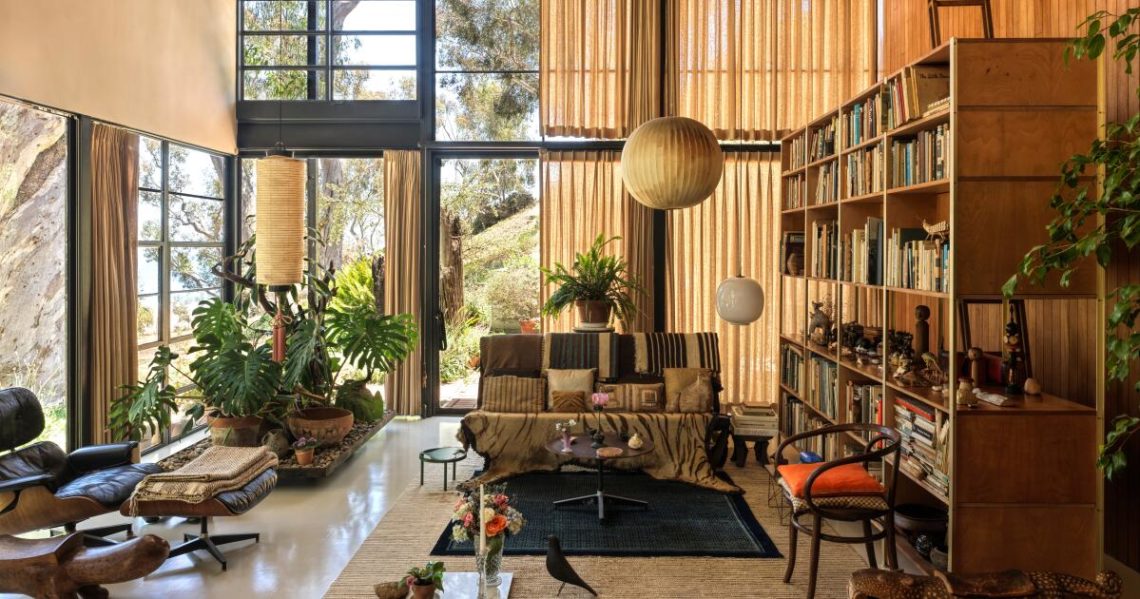On the second harrowing night of the Palisades fire in January, the security cameras surrounding the Eames House went dark.
“It was a long night,” said Eames Demetrios, grandson of designers Charles and Ray Eames and chairman of the board for the Charles & Ray Eames Foundation. “And then later that day the signal came back on.”
The house — a midcentury modern landmark designed and built in 1949, also known as Case Study House No. 8 — was still standing. But Demetrios soon went back to worrying. A neighbor who had stayed to battle the blaze with a garden hose reported that a nearby tree had caught fire.
“I thought, ‘OK, this is it. It’s coming,’” said Eames.
But the water-dropping helicopters came first and then — mercifully — the wind died down.
The Eames House was saved, but it was covered in soot and sustained a substantial amount of smoke damage. The residence, with its 31,000 historic objects, closed for five months while it underwent extensive cleaning and repairs — the most intensive of which involved hiring a disaster recovery team to hand-wipe the fragile structure while wearing protective gear.
The compound finally reopened late last month for tours on an appointment basis — and it unveiled its adjacent studio to the public for the very first time. The two structures are connected by a narrow walkway, and the Eameses often left doors and windows open, creating a natural flow between the spaces. As the creative nerve center of the site, the studio is where the Eameses spent the bulk of their time working on various projects. It will serve as a multipurpose staging ground for exhibitions, workshops and panel discussions, as well as a place for the community to gather and hold events, said Demetrios.
This notable change comes with another major announcement: the launch of a new and expanded Charles & Ray Eames Foundation, which unites the cultural and educational programming formerly done by the Eames Office — run by all five of the Eames grandchildren — with the preservation efforts of the Eames House Preservation Foundation.
The new foundation’s executive director, Adrienne Luce, was in the process of being hired when the fires hit, and she recalled being told before her last interview, “Look, if the house does not survive, they’re still building this new global, international foundation.”
Luce said she sees the new foundation as “the connective tissue between scholars and important collections globally.” Next year she’s planning to host a conference or summit in order to gather “diverse stakeholders from all over the world to advance thinking around the Eames’ design legacy” and to hopefully collaborate on future projects.
What Luce, Demetrios and the board of directors could not anticipate before the fire was how much this new era of the foundation’s — and the house’s — existence would be affected by issues of preservation in the face of mounting ecological and climate disasters, as well as the community engagement that became increasingly urgent and necessary in the wake of the fires.
Luce said there are plans to offer free admission to first responders as well as to residents of Pacific Palisades and Altadena, which was ravaged by the Eaton fire. With the grounds and studio now open, the foundation has invited the Palisades Library to hold family storytimes and book clubs onsite. It has also hosted a wide variety of community-driven events.
Of particular note, the foundation welcomed a gathering for a new nonprofit called Case Study: Adapt, which was co-founded by Dustin Bramell, whose house burned down in the Palisades fire. The organization partnered with Architectural Digest to recruit 10 L.A.-based architecture firms to pair each with one to two families who lost their homes in the fires in order to build inventive houses under 3,000 square feet, surrounded by fire-safe landscaping.
This, of course, mirrors how the Eames House was built. The original Case Study homes were commissioned by Arts & Architecture magazine in the wake of World War II to spark architectural innovation by challenging architects to utilize new materials and technologies to design progressive — but modest — homes in Southern California.
The Eames House is a raised steel-and-glass structure built into a hillside on the edge of a sun-dappled meadow in a eucalyptus grove on North Chautauqua Boulevard, with a view of the Pacific Ocean. The husband and wife duo — architect Charles and painter Ray — approached the project with the holistic, multidisciplinary thinking that they put into all their design work.
“Charles and Ray really felt that the best design addresses real human need,” noted Luce, which is perhaps why their most famous creations are the Eames lounge and dining chairs. But the pair also excelled at photography, film, graphic design and even whimsical toys and sculptures.
In 1957 they created the so-called Solar Do-Nothing Machine, which harnessed solar energy to power an aluminum toy that joyously whirled and spun. They made short films about many of their projects. Demetrios is particularly fond of “Toccata for Toy Trains,” which was created in 1957 and inspired by a toy locomotive gifted to the couple by director and friend Billy Wilder. The film features footage of toy trains running on a track with music by Elmer Bernstein, who frequently collaborated with the couple on their movies.
Demetrios pulled up the video on YouTube. Charles narrates the film in a calm voice tinged with the comforting fuzz of an old recording.
“Most of the trains we have used are old. Some are quite old. The reason for this is perhaps in the more recent years, we seem to have lost the knack of making real toys,” he says. “Most old ones have a direct and unembarrassed manner that give us a special kind of pleasure, a pleasure different from the admiration we may feel for the perfect little copy of the real thing. In a good old toy, there is apt to be nothing self-conscious about the use of materials. What is wood, is wood. What is tin, is tin. What is cast, is beautifully cast.”
That, declared Demetrios, closing out of the video, “is the most Eamesian narration ever.”
The idea raised by the film, he said, is the honest use of materials.
“That’s why they were able to not be too fussy about the past, while at the same time loving it and still embracing the future,” he said. “I mean, they made the first plastic chair. They made the first molded plywood chair. They were the first to use aluminum in a certain way.”
The new foundation seeks to build on the depth and breath of Charles and Ray Eames’ multidisciplinary legacy — and the technically stunning and deeply beautiful home they built. Plus, the couple’s ideas about sustainability — preserving natural landscapes and integrating them into their designs, rather than razing or altering them — have never been more resonant.
“One of the unique things about this place is that the grounds are authentic. Think the contents are authentic. The structure is authentic. The landscape’s authentic,” said Demetrios. “And important people did important work here.”
The Eames House is one of only two heritage sites in North America, along with the Salk Institute in San Diego, that the Getty Conservation Institute has worked with to create a comprehensive preservation plan for the next century — and that work, which is compiled in an extensive book, became crucial to the restoration process after the fire.
“There’s been a lot of rigorous scholarly studies and thinking behind all of the different conservation aspects of the site,” said Luce.
The Eames House has achieved a level of international renown reserved for some of the world’s most revered historic destinations. The scholar who devised the climate control plan for the house did the same thing for King Tut’s tomb.
The post After Palisades fire, Eames House reopens with a surprise: new access to a private space appeared first on Los Angeles Times.




